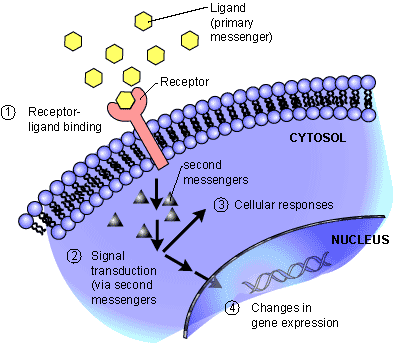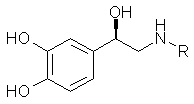AQA BIOL5 Biology Unit 5 Exam - 22nd June 2011
Scroll to see replies
Plenty of stuff bind to protein receptors on the cell membrane - antibodies and so on. It isn't exclusively enzymes.

Adrenaline looks like that

It just needs hydrogen bond from the OH and NH groups (I suspect) with the receptor protein.
 are you serious?!
are you serious?!Unfortunately yes.
 It was the specimen mark scheme though, hopefully for the real exam they'd notice their mistake!
It was the specimen mark scheme though, hopefully for the real exam they'd notice their mistake!Ahh right, thanks alot!

Well, probably not to such a great extent, but you should definitely revise is as they were the key themes of Unit 4.
i dont knw how u managed that
without revision there were some bits where i got full marks
and some questions where i got no marks at all
im just hoping that the bio5 is like the bio4 cos i heard there was hardly hsw in bio4
Basically, because every cell in your body contains the same DNA, every cell has the potential to code for ANY protein. However, we don't want that, as for example, we don't need insulin to be coded for and made anywhere else other than beta cells. So...different genes in different cells are turned on or off (expressed/not expressed), depending on the cell function/requirements. This is called gene expression, and is controlled by preventing transcription or breaking down mRNA before it's translated.
Hope this helps

your describing pluripotent stem cells. you don't use totipotent cells in research

Pluripotent cells cannot turn into the blastocyst - but they can turn into everything else.
There's a specimen paper on the AQA website but that's it. They don't run Unit 5 in January.


Hmm better try the specimen paper then! Thanks!
Structure of carbohydrates and Proteins (For essays)
Respiration and photosynthesis (For essays)
How the SAN functions (Relevent to Unit 5)
How meiosis works (Relevent to unit 5)
Tests for reducing sugars, starch and proteins (It just seems like it could be a synoptic 2 marker)

Pluripotent cells cannot turn into the blastocyst - but they can turn into everything else.
Is this in the spec? In the book, all it says is "stem cells also occur at the earliest stage of development of an embryo, these are embryonic cells."
One of my biology books say that "high blood pressure is detected by baroreceptors, then impulses are sent to the medulla oblongata, sending impulses along parasympathetic newurons, which secrete acetylecholine, which then binds to receptors on the SAN"
Whereas my other biology book says that " high blood pressure is detected by baroreceptors, then impulses are sent to the center in the medulla oblongata that decreases heart rate, which then increases the frequency of impulses to the SAN via the parasympathetic nervous system"
What should I say in my exam then?? :/
I don't know. Totipotent stem cells are not embryonic stem cells...
Embryonic stem cells are pluripotent stem cells derived from the inner cell mass of the blastocyst
The error rates get higher as the DNA gets longer - hence there is a limit to the size of fragment that can be amplified by PCR. Also, the chances of the polymerase falling off the DNA strand increase. In addition, the chances of non-specific primer binding also increase.
PCR works best for fragments between 200 bp to 2000 bp.
Well Kinesis is just a non-directional response that changes the rate of turning and speed. It doesn't have to work like that...
for example
As long as you remember the key features (e.g. replica plating if the antibiotic is going to kill the bacteria that have incorporated the plasmid), you should be fine. Can't help you with the number of marks per question thing though; we don't really have enough to go on yet.
Hey yh i get that but why will the sample be small, its still a whole piece of dna your extracting??? and you have 46 chromosomes, so would you extract each chromosome in the fingerprinting for parental ones i dont get it?
for example
But in the NT book questions, it says more turns= stays in favourable conditions longer


Yeah they could do that, it's not the only example of kinesis - but it is an example of kinesis...
Embryonic stem cells are pluripotent stem cells derived from the inner cell mass of the blastocyst
Embryonic stem cells (at the 16 cell stage) are totipotent - each cells is capable of regenerating to all the cells in the body, including the umbilical cord (and therefore a new foetus)
Beyond the 16 cell stage, they differentiate into two layers and become pluripotent, at this stage they can only differentiate into one of the 3 tissue types - digestive organs, skeletal system or nervous system. They cannot develop into umbilical tissue, hence incapable of forming a new foetus.
Adult stem cells are multipotent, hence not as powerful as embryonic stem cells
Here is a website which explains this quiet well:
http://biomed.brown.edu/Courses/BI108/BI108_2002_Groups/pancstems/stemcell/stemcellsclassversatility.htm
Quick Reply
Related discussions
- GCSE Exam Discussions 2024
- A-level Exam Discussions 2024
- Over 500 questions on AQA Bio Unit 4 + Current Spec and old Spec papers + MS!
- GCSE Exam Discussions 2023
- A Level Exam Discussions 2023
- How do you get A's in Biology A levels
- GCSE Biology Study Group 2022-2023
- AQA Chem Unit 1 May 22nd 2015 *OFFICIAL THREAD*
- A-level Biology Study Group 2022-2023
- School is killing me - Y11 "GYG" 2022
- GCSE 2024 timetable
- A-level Biology Study Group 2023-2024
- KCL Summer 2024 Accommodation Available
- KCL Summer 2024 Accommodation Available
- AQA GCSE Chemistry Paper 2 Foundation Tier (8462 2F) - 13 June 2023 [Exam Chat]
- GCSE 2023 Grade Boundaries (All Exam Boards)
- people who have done/are doing A-level biology with eduqas is it bad?
- btec applied science extended certificate aqa
- WJEC A-Level Biology Unit 4 (A2) [16th June 2023] Exam Chat
- A Level Advice
Latest
Last reply 8 minutes ago
Official University College London Applicant Thread for 2024Last reply 14 minutes ago
AQA GCSE English Literature Paper 1 (8702/1) - 13th May 2024 [Exam Chat]Last reply 35 minutes ago
Official: University of Bristol A100 2024 Entry ApplicantsLast reply 1 hour ago
2023 ** Borders and Enforcement, Crime & Compliance - ICE - Immigration OfficersLast reply 1 hour ago
Official University of Edinburgh Applicant Thread for 2024Last reply 1 hour ago
Can I do economics degree without a level maths?Last reply 2 hours ago
BAE systems degree apprenticeships September 2024Last reply 2 hours ago
Government Social Research Placement interview questionsLast reply 2 hours ago
Official University of St Andrews Applicant Thread for 2024Trending
Last reply 4 hours ago
OCR A-Level Biology A Paper 1 (H420/01) - 5th June 2024 [Exam Chat]Last reply 7 hours ago
AQA GCSE Biology Paper 1 (Higher Combined) 8464/1H - 10th May 2024 [Exam Chat]Last reply 2 days ago
AQA GCSE Biology Paper 1 Triple Higher Tier 10th May 2024 [Exam Chat]Last reply 2 days ago
Edexcel A-level Salter's-Nuffield Advanced Biology Papers 1, 2, 3 (9BN0 01-03)Last reply 1 week ago
Unofficial Mark scheme: AQA GCSE Biology Paper 1 Triple Higher Tier 16th May 2023Last reply 2 weeks ago
Edexcel A-level Biology A (Salters-Nuffield) Paper 3 - 19th June 2024 [Exam Chat]Posted 2 weeks ago
Edexcel GCSE Combined Science Paper 1 Biology 1 Higher - 10th May 2024 [Exam Chat]Last reply 3 weeks ago
OCR A-Level Biology A Paper 2 (H420/02) - 14th June 2024 [Exam Chat]Last reply 3 weeks ago
OCR A-Level Biology A Paper 3 (H420/03) - 19th June 2024 [Exam Chat]Last reply 2 months ago
AQA GCSE Biology Paper 2 (Higher Tier Combined) 8464/2H - 9th June 2023 [Exam Chat]Last reply 3 months ago
Unofficial Mark scheme: AQA GCSE Biology Higher Combined 8464/1H 16th May 2023Last reply 5 months ago
AQA GCSE Biology Paper 1 (Higher Combined) 8464/1H - 16th May 2023 [Exam Chat]Last reply 5 months ago
Edexcel GCSE Biology Paper 1 Higher Combined 1SC0 1BH - 16th May 2023 [Exam Chat]Last reply 9 months ago
Edexcel GCSE Biology Paper 2 Higher Combined 1SC0 2BH - 9th Jun 2023 [Exam Chat]Last reply 10 months ago
Edexcel A-level Biology B Paper 3 (9BI0 03) - 21st June 2023 [Exam Chat]Trending
Last reply 4 hours ago
OCR A-Level Biology A Paper 1 (H420/01) - 5th June 2024 [Exam Chat]Last reply 7 hours ago
AQA GCSE Biology Paper 1 (Higher Combined) 8464/1H - 10th May 2024 [Exam Chat]Last reply 2 days ago
AQA GCSE Biology Paper 1 Triple Higher Tier 10th May 2024 [Exam Chat]Last reply 2 days ago
Edexcel A-level Salter's-Nuffield Advanced Biology Papers 1, 2, 3 (9BN0 01-03)Last reply 1 week ago
Unofficial Mark scheme: AQA GCSE Biology Paper 1 Triple Higher Tier 16th May 2023Last reply 2 weeks ago
Edexcel A-level Biology A (Salters-Nuffield) Paper 3 - 19th June 2024 [Exam Chat]Posted 2 weeks ago
Edexcel GCSE Combined Science Paper 1 Biology 1 Higher - 10th May 2024 [Exam Chat]Last reply 3 weeks ago
OCR A-Level Biology A Paper 2 (H420/02) - 14th June 2024 [Exam Chat]Last reply 3 weeks ago
OCR A-Level Biology A Paper 3 (H420/03) - 19th June 2024 [Exam Chat]Last reply 2 months ago
AQA GCSE Biology Paper 2 (Higher Tier Combined) 8464/2H - 9th June 2023 [Exam Chat]Last reply 3 months ago
Unofficial Mark scheme: AQA GCSE Biology Higher Combined 8464/1H 16th May 2023Last reply 5 months ago
AQA GCSE Biology Paper 1 (Higher Combined) 8464/1H - 16th May 2023 [Exam Chat]Last reply 5 months ago
Edexcel GCSE Biology Paper 1 Higher Combined 1SC0 1BH - 16th May 2023 [Exam Chat]Last reply 9 months ago
Edexcel GCSE Biology Paper 2 Higher Combined 1SC0 2BH - 9th Jun 2023 [Exam Chat]Last reply 10 months ago
Edexcel A-level Biology B Paper 3 (9BI0 03) - 21st June 2023 [Exam Chat]



